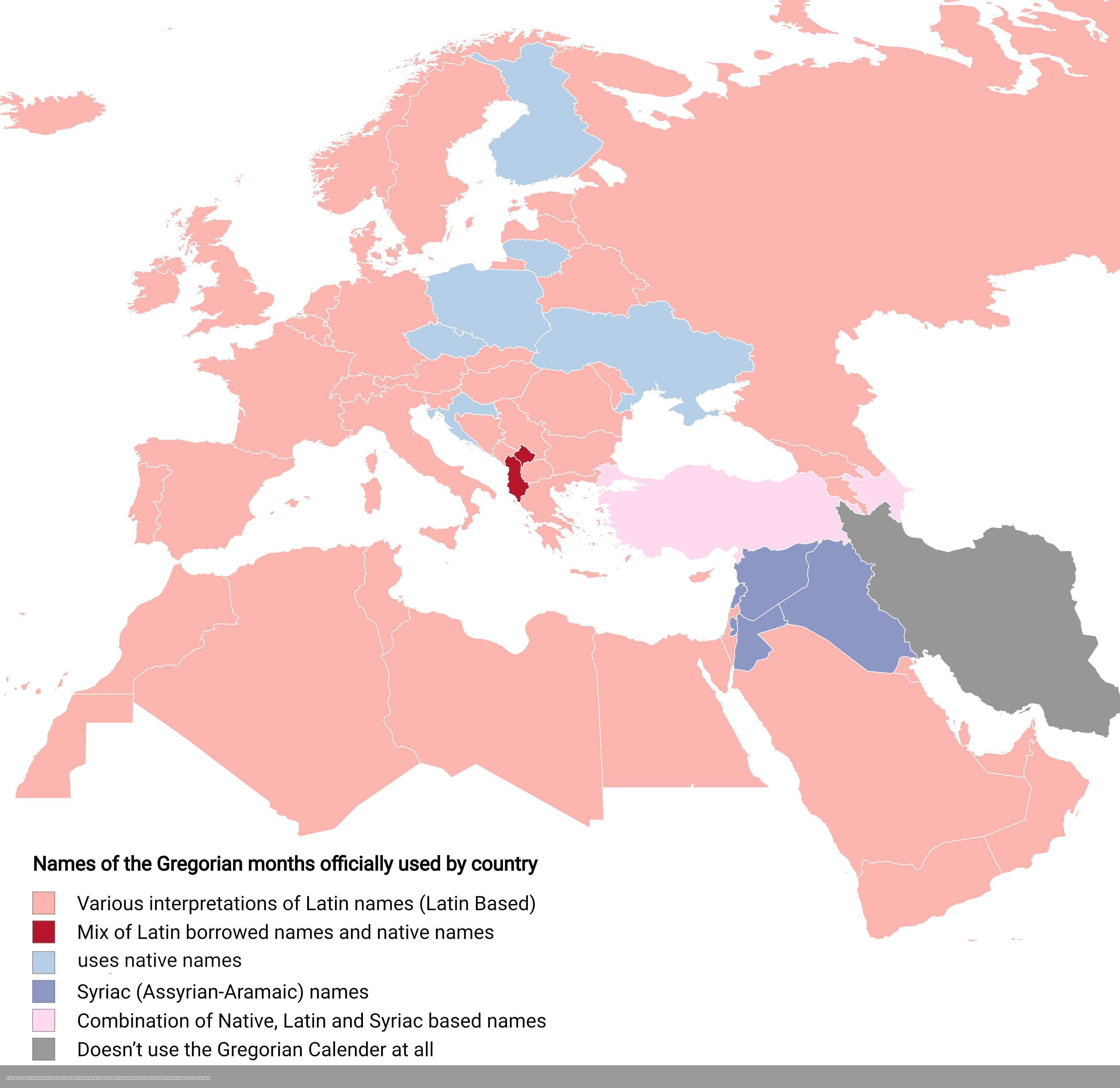Map of Month Names in the Gregorian Calendar by Country


David Chen
Data Visualization Specialist
David Chen is an expert in transforming complex geographic datasets into compelling visual narratives. He combines his background in computer science ...
Geographic Analysis
What This Map Shows
This map provides a fascinating look at the names of the months in the Gregorian calendar as they are officially used in various countries around the world. The Gregorian calendar, introduced by Pope Gregory XIII in 1582, has become the global standard for civil use, marking time with a structure of 12 months. However, while the month names are universally recognized in English, many countries have their own unique names for these months, often rooted in cultural, historical, or linguistic traditions. This visualization highlights those differences, showcasing the diversity of languages and cultures around the globe.
Deep Dive into Month Names in the Gregorian Calendar
The Gregorian calendar consists of 12 months: January, February, March, April, May, June, July, August, September, October, November, and December. However, the names of these months can vary significantly from one country to another. For instance, in Spain, the month of January is referred to as "enero," while in France, it is "janvier." These names often derive from Latin, the language in which the calendar was originally formulated, but they have evolved in ways that reflect the unique linguistic and cultural characteristics of each nation.
Interestingly, some countries maintain the Latin roots very closely, while others have adapted the names to fit their phonetic and grammatical structures. For example, in Italian, January is "gennaio," which closely mirrors its Latin origin. Conversely, in Japanese, the months are typically referred to by their numerical order, with January being "ichigatsu" (一月), meaning "first month." This numeric system offers a stark contrast to the more traditional names used in Western languages and showcases Japan's unique approach to timekeeping.
Moreover, variations in month names can also reflect historical influences. Countries that experienced significant Roman influence, such as those in Southern Europe, often retain month names that are quite similar to the Latin originals. In contrast, nations that have undergone various cultural shifts or colonization may have month names that reflect a blend of indigenous languages and influences from colonizing nations.
One fascinating aspect is how some cultures have integrated their traditional calendars with the Gregorian system, resulting in hybrid month names. For instance, in some regions of India, the months of the Gregorian calendar are often referred to by their names in regional languages, reflecting both the global standard and local traditions. This blending of calendars is particularly evident in multi-cultural societies where different groups coexist, leading to a rich tapestry of linguistic diversity.
Regional Analysis
When we break down the map by regions, interesting patterns emerge. In Europe, for instance, many countries use month names that are derivatives of Latin, which reflects the shared historical and linguistic heritage across the continent. Countries like Italy, France, and Spain have names that are quite similar, indicating a common root and cultural exchange over the centuries.
In contrast, looking at Asia, the situation is more varied. Countries like China and Japan diverge significantly from the Gregorian month names. In China, the traditional lunar calendar still holds importance, and thus the month names in Mandarin Chinese are different altogether. Similarly, in Japan, while the Gregorian calendar is widely used, the traditional month names continue to be prevalent, showing a fascinating blend of old and new.
Africa presents yet another layer of complexity. With its multitude of languages and cultures, countries often have varied month names, influenced by local languages and colonial histories. For example, in South Africa, English month names are commonly used alongside indigenous names, reflecting the country's diverse cultural tapestry.
Significance and Impact
Understanding the month names used across different countries has significant implications. It sheds light not only on the linguistic diversity of our world but also on how different cultures perceive and interact with time. This knowledge can be crucial for various fields, including international relations, cultural studies, and global business practices.
Moreover, as globalization continues to influence local cultures, there is a growing trend towards the adoption of English month names in many non-English speaking countries. However, this trend raises questions about cultural preservation and the impact of globalization on local languages. Will traditional names fade away? Or will they find a place alongside their English counterparts?
As we continue to navigate a globalized world, understanding cultural nuances like these will be key to fostering better communication and cooperation across nations. The month names we use may seem trivial at first glance, but they represent a rich tapestry of history, culture, and identity that is worth exploring further.
Visualization Details
- Published
- August 4, 2025
- Views
- 196
Comments
Loading comments...